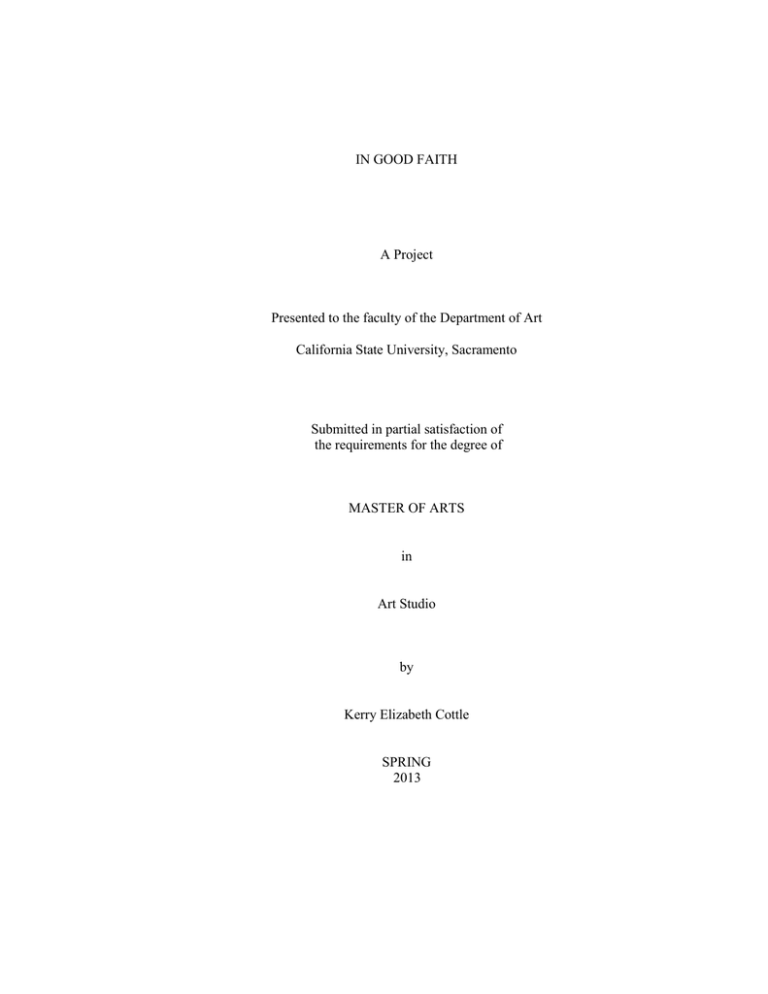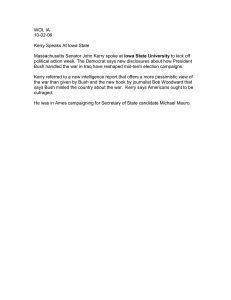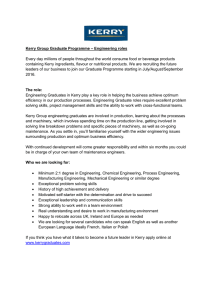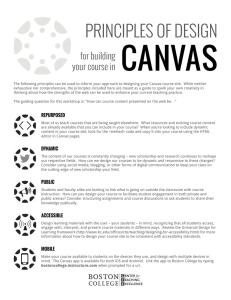
IN GOOD FAITH
A Project
Presented to the faculty of the Department of Art
California State University, Sacramento
Submitted in partial satisfaction of
the requirements for the degree of
MASTER OF ARTS
in
Art Studio
by
Kerry Elizabeth Cottle
SPRING
2013
©2013
Kerry Elizabeth Cottle
ALL RIGHTS RESERVED
ii
IN GOOD FAITH
A Project
by
Kerry Elizabeth Cottle
Approved by:
__________________________________, Committee Chair
Andrew Connelly, M.F.A.
__________________________________, Second Reader
Thomas Monteith, M.F.A.
____________________________
Date
iii
Student: Kerry Elizabeth Cottle
I certify that this student has met the requirements for format contained in the University format
manual, and that this project is suitable for shelving in the Library and credit is to be awarded for
the project.
__________________________, Graduate Coordinator
Andrew Connelly, M.F.A.
Department of Art
iv
___________________
Date
Abstract
of
IN GOOD FAITH
by
Kerry Elizabeth Cottle
I wished to discover what it meant to devote myself to something that could help me
determine my place in the world. To put myself into the work and then draw wisdom from it to
provide a foundation on which I could begin to both improve myself and the painting was my
ultimate goal. I wanted to begin to understand what it meant to make a good painting and what
kind of person it might take to make one. This project will shed light on the process of painting
and what that process taught me.
_______________________, Committee Chair
Andrew Connelly, M.F.A.
_______________________
Date
v
TABLE OF CONTENTS
Page
List of Figures ........................................................................................................................ vii
THE BEGINNING.................................................................................................................... 1
MATTER .................................................................................................................................. 2
HUMILITY ............................................................................................................................... 4
THE OPPOSITE ....................................................................................................................... 7
EPILOGUE…………………………………………………………………………………... 9
Bibliography…………………………………………………………………………... …...
vi
22
LIST OF FIGURES
Figures
Page
1.
Untitled, 2011, Kerry Cottle, oil on canvas, 40x40 in………………..……………… 10
2.
Untitled, 2012, Kerry Cottle, oil on canvas, 40x40 in…………………..………….…11
3.
Untitled, 2012, Kerry Cottle, oil on canvas, 36x36 in……………………..………….12
4.
ZimZum, 2012, Kerry Cottle, oil on canvas, 48x48 in...………………..……………..13
5.
Untitled, 2012, Kerry Cottle, oil on canvas, 36x36 in…………………..……………..14
6.
Untitled, 2012, Kerry Cottle, oil on canvas, 48x48 in.………………..……………….15
7.
Volcano, 2012, Kerry Cottle, oil on canvas, 48x48 in.…………………..…………….16
8.
Untitled, 2012, Kerry Cottle, oil on canvas, 40x40 in.…………………..…………….17
9.
Riss, 2013, Kerry Cottle, oil on canvas, 66x66 in………………………..……………18
10.
The Ceiling, 2013, Kerry Cottle, oil on canvas, 60x60 in.…………..………………...19
11.
Opponents belong to each other, 2013, Kerry Cottle, oil on canvas, 66x66 in….…….20
12.
Untitled, 2013, Kerry Cottle, oil on canvas, 60x60 in………………..………………..21
vii
1
THE BEGINNING
“All art is incarnational, full of matter, and for the same reason, to
make actual the mystery. Pound is right: some knowledge cannot survive
abstraction, and to preserve this knowledge we must have art. The
liquid light, the nous, the fecundity of nature, the feeling of the
soul in ascent—only the imagination can articulate our apprehension
of these things, and the imagination speaks to us in images.” (Hyde)
The only way to understand something in a resounding bodily way is to place
yourself before an entity that has the ability to take you out of yourself. The Grand
Canyon does this, Yosemite, and the ocean. I have experienced an equally reverent
feeling in the midst of works of art. They remind me of the profundity of my existence—
how lucky I am to be here, to experience this. Art is created by a sort of alchemical bond
between disparate elements that in turn ignite into a filament of light and serve as what
Elaine Scarry has termed a “tear” in our existence. These works of art or nature simply
act as reminders.
How any given person or set of circumstances can accomplish such a work is a
part of the mystery. The factors that create the work, the effect they can have on people,
are also part of the mystery. It seems to me that the only way to potentially get close to
understanding this is to strive, in good faith.
2
MATTER
I believe in the idea of universal symbols. The symbols in my work are ones that
I discover in the world and adopt as my own. The circle is profound. It exemplifies many
things in a reductive, honest way. When I saw Kazimir Malevich’s Black Circle, I was
struck by its power. It is a dark beacon. It is an icon that alludes to the connective nature
of all things. Circles are vast.
The wheel, the endless cycle is contained in the circle. This, when combined with
another symbolic shape—the triangle—form a teardrop. The teardrop is significant to me
in that it can both act as circle and triangle, but also, arrow. It serves a purpose of
directing one’s attention, and I direct this attention upwards. The pursuit of art is the
pursuit of elevating the human spirit. I use images to inject a feeling of hope in a place
where hope is not always present.
The column, both anatomically and architecturally, is a symbol of strength. I use
columns to remind us that we must emulate their strength and carry our own weight. I
build them to remind myself of that, too.
The doorway—also a keyhole—allows us to see what is beyond what we
construct for ourselves. It is symbolic of awareness; it is a threshold. Through them, we
pass.
3
In objects or entities that I consider to be art there is a stark and confrontational
power that speaks to me very clearly. These things are at once dark and beautiful, full of
intensity. They are more than just things--they have substance and impact. I am very
interested in attempting to create something of such intensity with very meager means. I
use only very few elements: line, shifts, the grid, and the unreliable nature of pouring
thinned paint to communicate an upward and rising motion. I want to create something
that is itself, something that is actualized.
I collect elements that have begun to take on personal meaning, and assemble
them into a composition that suggests a world where struggle is imminent. The attempt
for wholeness is sought after but the ambiguity of what goes on in the interim prevails. In
this way, the work contains life.
4
HUMILITY
“If you had a two-sided chalkboard in your living room I’d write humility on one side and
surrender on the other for you. That is what I think you need to find and do to get
yourself out of the funk you’re in. The most fascinating thing to me about your letter is
that buried beneath all the anxiety and sorrow and fear and self-loathing, there’s
arrogance at its core. It presumes you should be successful at 26, when really it takes
most writers so much longer to get there. It laments that you’ll never be as good as David
Foster Wallace—a genius, a master of the craft—while at the same time describing how
little you write. You loathe yourself, and yet you’re consumed by the grandiose ideas you
have about your own importance. You’re up too high and down too low. Neither is the
place where we get any work done.” (Strayed)
Painting confronts me with myself—it has mirroring capabilities. In the work, I
see the world behind me reflected back. It has taught me humility. I hope it always will. It
demands time and energy and discipline. This is the most valuable part of the process of
creating—that if I give myself to it, it will reveal things to me, ad infinitum. The work
asks that I allow myself to quiet my ego—the ego interferes with the non-judgmental act
of seeing—and that I disengage from the past and the future, and that I am simply here,
now.
On a personal level, painting is a tool. Painting is a method that I use to inform
myself. The canvas serves as a small, manageable world where I am able to test myself
and solve problems that in every way relate to how I operate in the world at large.
Painting has confronted me most notably with the problem of inaction. This inaction is a
result of the fear of doing irreversible damage as well as a large sense of uncertainty. This
inaction stalls work, and limits it.
5
Uncertainty is not something you can deny. It just is. Sometimes it seems dark
and nebulous. Other times, I realize that it only makes the world greater and more joyful.
In uncertainty I have freedom.
Fear has been very present at times, but I am getting the feeling that fear does not
serve me or the work. I plan on replacing this fear with confidence. This will be my new
experiment. It is difficult to let go of what I have relied upon in the past, but in order to
change, I must.
I used to believe that painting was a process of receiving and then transcribing
what I recieved, but now I realize that I must be aggressive and exert my will. I must give
more to the work if I wish the work to give back. The stakes are as high as I want them to
be. If I find myself competing with others, then something is amiss. I am my only
competitor.
This newfound will to act reminds me of a piece by Nigel Poor called Tiny
Writing. In this piece she uses three pieces of paper to record how her actions spawn
thoughts and the corresponding emotion. The first page—with the least amount of
writing—contains the list of her daily, noteworthy actions. The second page contains the
corresponding thoughts that these actions invoke. The third page, which is filled
completely, has the emotions that result from both the actions and the thoughts. This, for
6
Poor, proves that “actions in our lives take up the smallest amount of space”, and that the
thought and emotion it thereby creates are truly what substantiates a life. What stuck with
me since the time I saw the piece three years ago was how little time was spent acting
and how unfortunate it was that most of our time is often whiled away in the isolation of
our isolated experiences. I realize that my work demands movement, and that the work is
catalyzed by a confidence in my voice and a faith in my vision.
There is a time and a place for being still, however. There is a balance that must
be achieved between being still and receptive, and being active and assertive. I consider
this balance a large part of the work; I haven’t mastered this yet.
7
THE OPPOSITE
“Bad faith is the opposite. It is the confidence that there is
corruption, not just that the covenants of men may be severed, but
that all things may be decomposed and broken into fragments (the old
sense of “Corruption”). Out of bad faith comes a longing for control,
for law and the police. Bad faith suspects that the gift will not come
back, that things won’t work out, that there is a scarcity so great in
the world that it will devour whatever gifts appear. In bad faith the
circle is broken.” (Hyde)
Confidence sometimes eludes me. When I am actively painting, I see and feel
very acutely that only progress can be made if I push on. The fear of losing what precious
things I have managed, or of overlooking those things and concealing them in favor of
something uglier and, perhaps, more real sometimes stops me in my tracks. I must pick
up again and proceed despite these fears. It is when the fear is too large a factor that the
circle becomes fractured.
Painting is just an act of making after all—no more, no less. This allows the work
to open up, to become less rigid, as well as less predictable and more genuine. Painting is
less an act of the cold intellect as it is an act of the intuition. Painting is a physical
process.
Painting the grid brings me true joy and is a devotional act for me. Not only am I
paying homage to Agnes Martin, who helped me to learn how to speak, but I am setting
up a structure on the canvas that is both strong and ephemeral—a foundation. The grid,
8
too, speaks of a longing for control while acting as a veil. The grid is paradoxical in this
sense.
Painting is to me a holy thing, and I am not ashamed.
The paintings contain my shortcomings, my fallibility. Fallibility is a part of the
work and what I find to be most interesting and relatable. The shortcomings are the
threads that tie the work to the rest of the world. They are what tie me to the work.
9
EPILOGUE
“…though the wide universe is full of good, no kernel of nourishing corn can come to
him but through his toil bestowed on that plot of ground which is given to him to till. The
power which resides in him is new in nature, and none but he knows what that is which
he can do, nor does he know until he has tried.” (Emerson )
This is the very beginning.
10
Figure 1. Untitled, 2011, Kerry Cottle, oil on canvas, 40x40 in.
11
Figure 2. Untitled, 2011, Kerry Cottle, oil on canvas, 40x40 in.
12
Figure 3. Untitled, 2012, Kerry Cottle, oil on canvas, 36x36 in.
13
Figure 4. ZimZum, 2012, Kerry Cottle, oil on canvas, 48x48 in.
14
Figure 5. Untitled, 2012, Kerry Cottle, oil on canvas, 36x36 in.
15
Figure 6. Untitled, 2012, Kerry Cottle, oil on canvas, 48x48 in.
16
Figure 7. Volcano, 2012, Kerry Cottle, oil on canvas, 48x48 in.
17
Figure 8. Untitled, 2012, Kerry Cottle, oil on canvas, 40x40 in.
18
Figure 9. Riss, 2013, Kerry Cottle, oil on canvas, 66x66 in.
19
Figure 10. The Ceiling, 2013, Kerry Cottle, oil on canvas, 60x60 in.
20
Figure 11. Opponents belong to each other, 2013, Kerry Cottle, oil on canvas, 66x66 in.
21
Figure 12. Untitled, 2013, Kerry Cottle, oil on canvas, 60x60 in.
22
BIBLIOGRAPHY
Hyde, Lewis. The Gift.
New York: Random House, 1983.
Strayed, Cheryl. "DEAR SUGAR, The Rumpus Advice Column”
Strayed’s column “Dear Sugar”, is a forum where people with questions come to
garner advice from the writer Cheryl Strayed. The questions submitted range
widely from the very colorful to the mundane, but are always relatable in some
way. Seemingly rich in life experience, Strayed answers her readers’ questions in
a refreshingly blunt and constructive manner. The column can be found at
http://therumpus.net/sections/blogs/dear-sugar/
Emerson, Ralph Waldo. Self-Reliance, and Other Essays.
New York: Dover Publications, 1993.




